What to Look For in the Night Sky: December
Special Stories
3 Dec 2021 5:00 AM
The nights are long, but they're cold! If you can stand the chill, there are some great night sky watching opportunities to be had during the month of December, including two meteor showers.
Spotting the International Space Station is always a great activity and is easy to do thanks to this handy tool. For detailed explanations and even more events, check out the “tonight” feature at EarthSky.
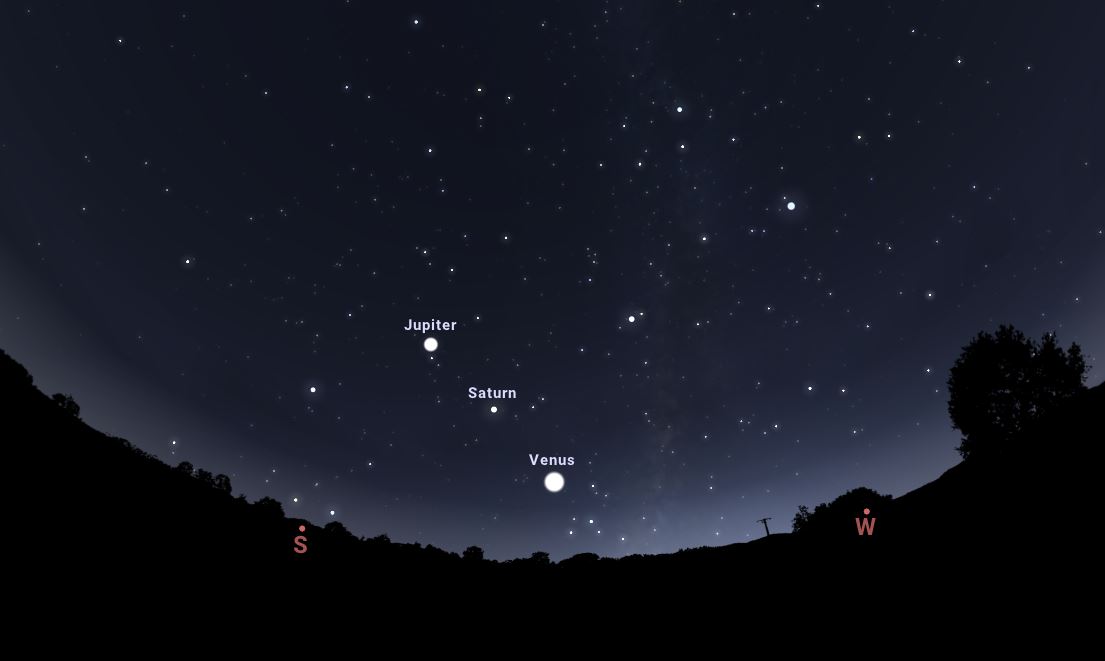 Image made with Stellarium
Venus is typically VERY bright. How bright is it? It's second only to the Moon when it comes to brightest in our night sky, also known as magnitude.
Why is early December special for Venus? It's going to be about as bright as it gets. Like the Moon, Venus goes through different phases. In early December, that phase is going to be full and it will be in a good position relative to the sun and earth to see in the evenings.
Head outside as the sun goes down, or shortly after, during the first week of December to see Venus easily outshining Saturn and Jupiter (which will be nearby) toward the southwest.
Image made with Stellarium
Venus is typically VERY bright. How bright is it? It's second only to the Moon when it comes to brightest in our night sky, also known as magnitude.
Why is early December special for Venus? It's going to be about as bright as it gets. Like the Moon, Venus goes through different phases. In early December, that phase is going to be full and it will be in a good position relative to the sun and earth to see in the evenings.
Head outside as the sun goes down, or shortly after, during the first week of December to see Venus easily outshining Saturn and Jupiter (which will be nearby) toward the southwest.
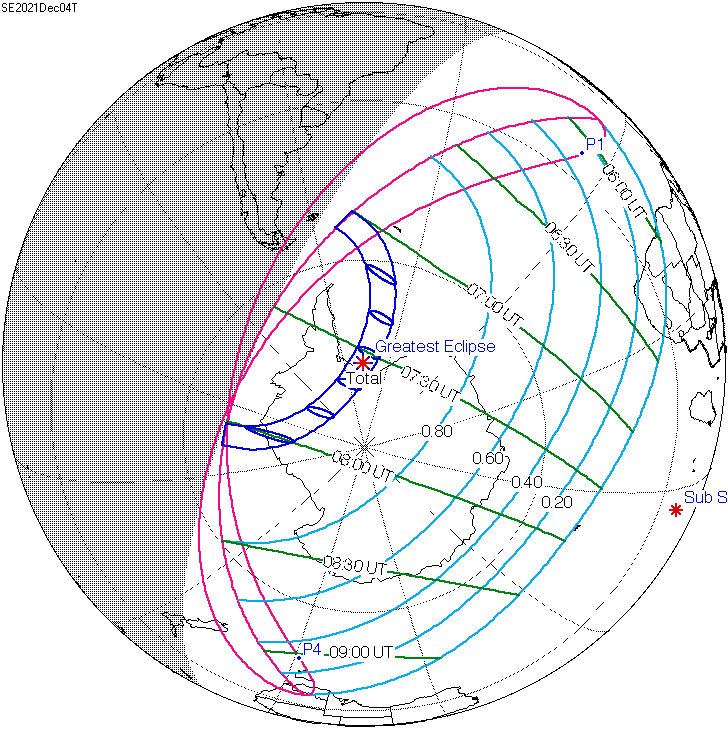 Image credit: NASA
If you're a penguin or a scientist in Antarctica, you're in luck. A total solar eclipse will occur over Antarctica as the moon completely covers the sun on December 4th. If you live anywhere else, you'll have to hope one of those penguins knows how to live stream.
Sorry, rest of the world.
Image credit: NASA
If you're a penguin or a scientist in Antarctica, you're in luck. A total solar eclipse will occur over Antarctica as the moon completely covers the sun on December 4th. If you live anywhere else, you'll have to hope one of those penguins knows how to live stream.
Sorry, rest of the world.
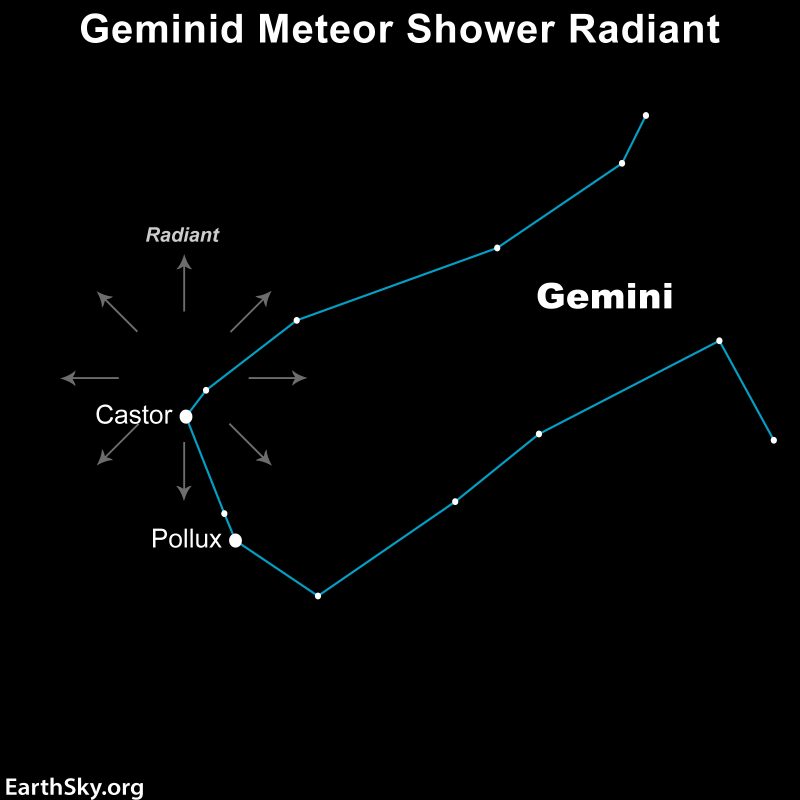 Image credit: Earhsky.org
The Geminids are typically a fantastic meteor shower, they just happen to occur when it's cold outside for many would be meteor enthusiasts.
Unfortunately the waxing gibbous moon will wash out many of this years meteors, but many brighter shooting stars will still be visible.
The pre-dawn hours of December 14th will present the best chance to see the greatest number of bright Geminids, if you have clear skies and are away from city lights. Look up after 2 a.m. local time, try to take in as much of the sky as possible (or look away from the moon), and hopefully you'll be lucky enough to see a handful of bright Geminids. When the moon isn't a factor, over 100 Geminids an hour are typical.
Image credit: Earhsky.org
The Geminids are typically a fantastic meteor shower, they just happen to occur when it's cold outside for many would be meteor enthusiasts.
Unfortunately the waxing gibbous moon will wash out many of this years meteors, but many brighter shooting stars will still be visible.
The pre-dawn hours of December 14th will present the best chance to see the greatest number of bright Geminids, if you have clear skies and are away from city lights. Look up after 2 a.m. local time, try to take in as much of the sky as possible (or look away from the moon), and hopefully you'll be lucky enough to see a handful of bright Geminids. When the moon isn't a factor, over 100 Geminids an hour are typical.
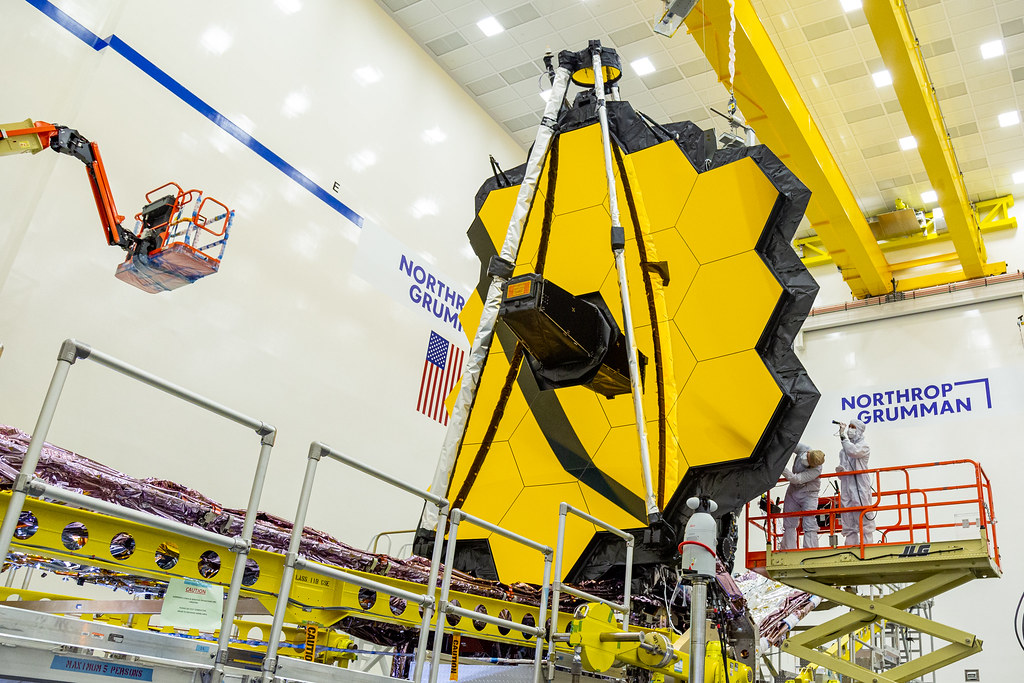 The James Webb Telescope being assembled at Northrop Gerumman. Image credit: NASA
Move over Hubble! Okay, the Hubble Telescope doesn't have to go anywhere, but the James Webb telescope is going to be a BIG deal.
This telescope is expected to be the premiere observatory for the next decade, hosting an array of impressive technology.
You won't be able to see launch locally in the United States, since the telescope will be launch from French Guiana, hopefully around the 18th of December. But you will be able to follow along online.
According to this NASA article, the telescope has safely arrived at the launch site. Click the link to read more about the launch and deployment timeline.
The James Webb Telescope being assembled at Northrop Gerumman. Image credit: NASA
Move over Hubble! Okay, the Hubble Telescope doesn't have to go anywhere, but the James Webb telescope is going to be a BIG deal.
This telescope is expected to be the premiere observatory for the next decade, hosting an array of impressive technology.
You won't be able to see launch locally in the United States, since the telescope will be launch from French Guiana, hopefully around the 18th of December. But you will be able to follow along online.
According to this NASA article, the telescope has safely arrived at the launch site. Click the link to read more about the launch and deployment timeline.
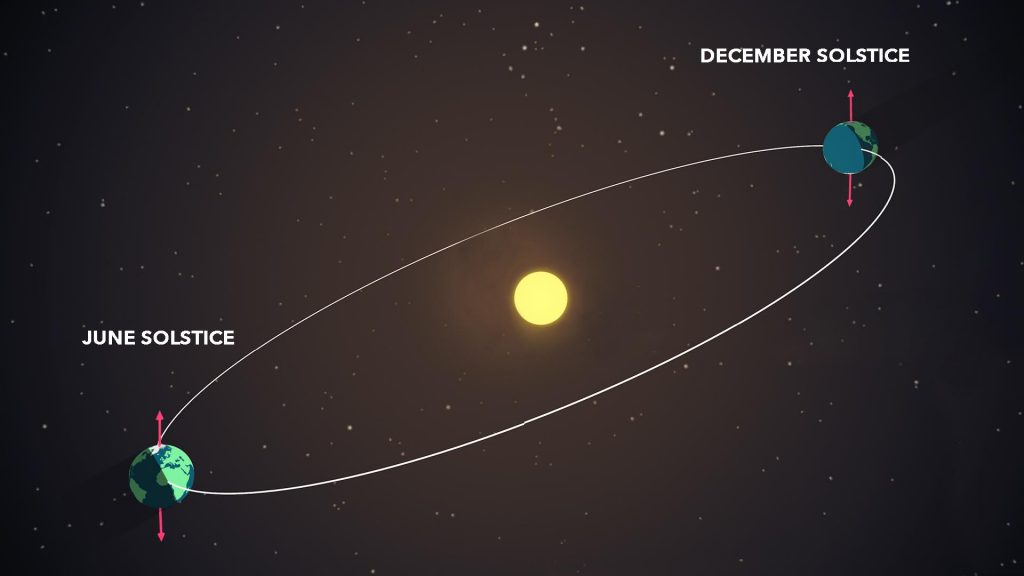 Image credit: NASA
Winter arrives on December 21st at 10:59 a.m. EST, 7:59 a.m. PST.
That's the moment in earth's orbit when it will start the long and slow tilt back toward the sun in the Northern Hemisphere. The winter solstice marks the 24 hour period with the least amount of daylight for the Northern Hemisphere, which means days begin to get longer and don't stop until the summer solstice toward the end of June.
Numerous religions and peoples around the world have festivals to celebrate the Winter Solstice, with many of these tied to celebrating the lengthening of days.
Image credit: NASA
Winter arrives on December 21st at 10:59 a.m. EST, 7:59 a.m. PST.
That's the moment in earth's orbit when it will start the long and slow tilt back toward the sun in the Northern Hemisphere. The winter solstice marks the 24 hour period with the least amount of daylight for the Northern Hemisphere, which means days begin to get longer and don't stop until the summer solstice toward the end of June.
Numerous religions and peoples around the world have festivals to celebrate the Winter Solstice, with many of these tied to celebrating the lengthening of days.
 Image credit: Earthsky.org
The annual Ursid meteor shower isn't the most prolific shower, but can still put on a beautiful show. Unfortunately, the waning gibbous moon will be a problem this year, concealing all but the brightest meteors.
Still, if you're going to be outside it won't hurt to look up occasionally to try to catch the odd bright Ursid or two.
Image credit: Earthsky.org
The annual Ursid meteor shower isn't the most prolific shower, but can still put on a beautiful show. Unfortunately, the waning gibbous moon will be a problem this year, concealing all but the brightest meteors.
Still, if you're going to be outside it won't hurt to look up occasionally to try to catch the odd bright Ursid or two.
December 3rd: Venus Shines
 Image made with Stellarium
Venus is typically VERY bright. How bright is it? It's second only to the Moon when it comes to brightest in our night sky, also known as magnitude.
Why is early December special for Venus? It's going to be about as bright as it gets. Like the Moon, Venus goes through different phases. In early December, that phase is going to be full and it will be in a good position relative to the sun and earth to see in the evenings.
Head outside as the sun goes down, or shortly after, during the first week of December to see Venus easily outshining Saturn and Jupiter (which will be nearby) toward the southwest.
Image made with Stellarium
Venus is typically VERY bright. How bright is it? It's second only to the Moon when it comes to brightest in our night sky, also known as magnitude.
Why is early December special for Venus? It's going to be about as bright as it gets. Like the Moon, Venus goes through different phases. In early December, that phase is going to be full and it will be in a good position relative to the sun and earth to see in the evenings.
Head outside as the sun goes down, or shortly after, during the first week of December to see Venus easily outshining Saturn and Jupiter (which will be nearby) toward the southwest.
December 4th: Total Solar Eclipse (For Penguins)
 Image credit: NASA
If you're a penguin or a scientist in Antarctica, you're in luck. A total solar eclipse will occur over Antarctica as the moon completely covers the sun on December 4th. If you live anywhere else, you'll have to hope one of those penguins knows how to live stream.
Sorry, rest of the world.
Image credit: NASA
If you're a penguin or a scientist in Antarctica, you're in luck. A total solar eclipse will occur over Antarctica as the moon completely covers the sun on December 4th. If you live anywhere else, you'll have to hope one of those penguins knows how to live stream.
Sorry, rest of the world.
December 13th-14th: Geminid Meteor Shower
 Image credit: Earhsky.org
The Geminids are typically a fantastic meteor shower, they just happen to occur when it's cold outside for many would be meteor enthusiasts.
Unfortunately the waxing gibbous moon will wash out many of this years meteors, but many brighter shooting stars will still be visible.
The pre-dawn hours of December 14th will present the best chance to see the greatest number of bright Geminids, if you have clear skies and are away from city lights. Look up after 2 a.m. local time, try to take in as much of the sky as possible (or look away from the moon), and hopefully you'll be lucky enough to see a handful of bright Geminids. When the moon isn't a factor, over 100 Geminids an hour are typical.
Image credit: Earhsky.org
The Geminids are typically a fantastic meteor shower, they just happen to occur when it's cold outside for many would be meteor enthusiasts.
Unfortunately the waxing gibbous moon will wash out many of this years meteors, but many brighter shooting stars will still be visible.
The pre-dawn hours of December 14th will present the best chance to see the greatest number of bright Geminids, if you have clear skies and are away from city lights. Look up after 2 a.m. local time, try to take in as much of the sky as possible (or look away from the moon), and hopefully you'll be lucky enough to see a handful of bright Geminids. When the moon isn't a factor, over 100 Geminids an hour are typical.
December 18th: James Webb Telescope Launch Target
 The James Webb Telescope being assembled at Northrop Gerumman. Image credit: NASA
Move over Hubble! Okay, the Hubble Telescope doesn't have to go anywhere, but the James Webb telescope is going to be a BIG deal.
This telescope is expected to be the premiere observatory for the next decade, hosting an array of impressive technology.
You won't be able to see launch locally in the United States, since the telescope will be launch from French Guiana, hopefully around the 18th of December. But you will be able to follow along online.
According to this NASA article, the telescope has safely arrived at the launch site. Click the link to read more about the launch and deployment timeline.
The James Webb Telescope being assembled at Northrop Gerumman. Image credit: NASA
Move over Hubble! Okay, the Hubble Telescope doesn't have to go anywhere, but the James Webb telescope is going to be a BIG deal.
This telescope is expected to be the premiere observatory for the next decade, hosting an array of impressive technology.
You won't be able to see launch locally in the United States, since the telescope will be launch from French Guiana, hopefully around the 18th of December. But you will be able to follow along online.
According to this NASA article, the telescope has safely arrived at the launch site. Click the link to read more about the launch and deployment timeline.
December 18th: Full Moon
The December full moon occurs just before midnight eastern time on December 18th, at 11:37 in case you want it down to the minute. The most common name is the cold moon, but is also known as the snow moon and the long night moon. Don't expect any extra razzle dazzle out this month's full moon, it's not "super" in size or brightness, but it's still our moon, which makes it pretty super.December 21st: Winter Solstice
 Image credit: NASA
Winter arrives on December 21st at 10:59 a.m. EST, 7:59 a.m. PST.
That's the moment in earth's orbit when it will start the long and slow tilt back toward the sun in the Northern Hemisphere. The winter solstice marks the 24 hour period with the least amount of daylight for the Northern Hemisphere, which means days begin to get longer and don't stop until the summer solstice toward the end of June.
Numerous religions and peoples around the world have festivals to celebrate the Winter Solstice, with many of these tied to celebrating the lengthening of days.
Image credit: NASA
Winter arrives on December 21st at 10:59 a.m. EST, 7:59 a.m. PST.
That's the moment in earth's orbit when it will start the long and slow tilt back toward the sun in the Northern Hemisphere. The winter solstice marks the 24 hour period with the least amount of daylight for the Northern Hemisphere, which means days begin to get longer and don't stop until the summer solstice toward the end of June.
Numerous religions and peoples around the world have festivals to celebrate the Winter Solstice, with many of these tied to celebrating the lengthening of days.
December 21st-22nd: Ursid Meteor Shower
 Image credit: Earthsky.org
The annual Ursid meteor shower isn't the most prolific shower, but can still put on a beautiful show. Unfortunately, the waning gibbous moon will be a problem this year, concealing all but the brightest meteors.
Still, if you're going to be outside it won't hurt to look up occasionally to try to catch the odd bright Ursid or two.
Image credit: Earthsky.org
The annual Ursid meteor shower isn't the most prolific shower, but can still put on a beautiful show. Unfortunately, the waning gibbous moon will be a problem this year, concealing all but the brightest meteors.
Still, if you're going to be outside it won't hurt to look up occasionally to try to catch the odd bright Ursid or two.All Weather News
More